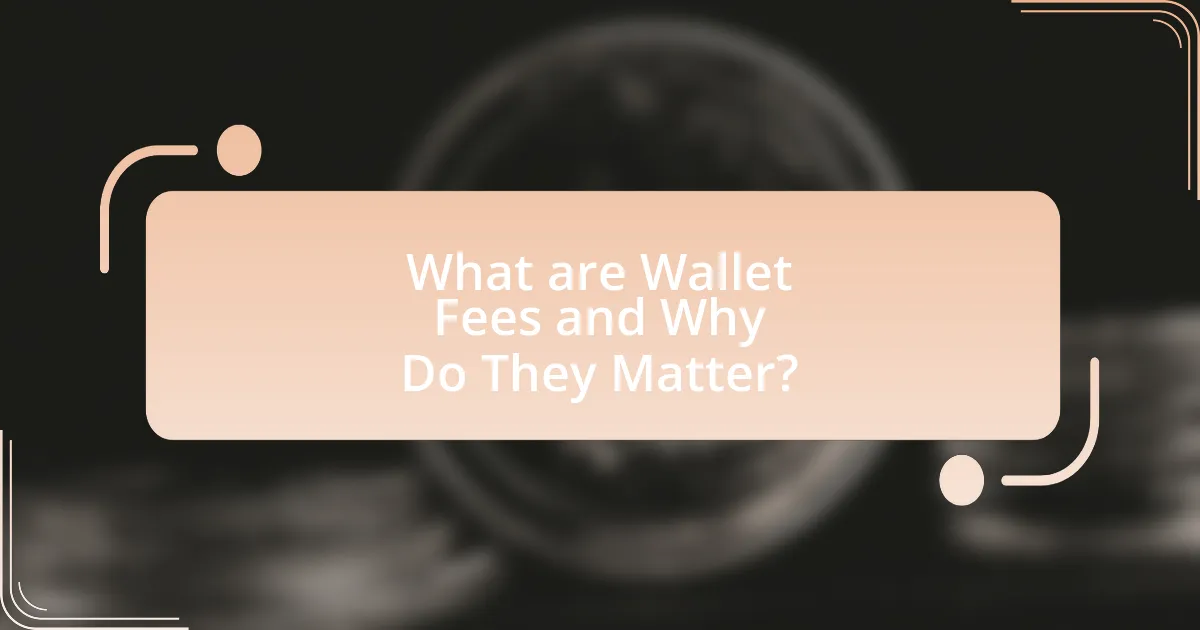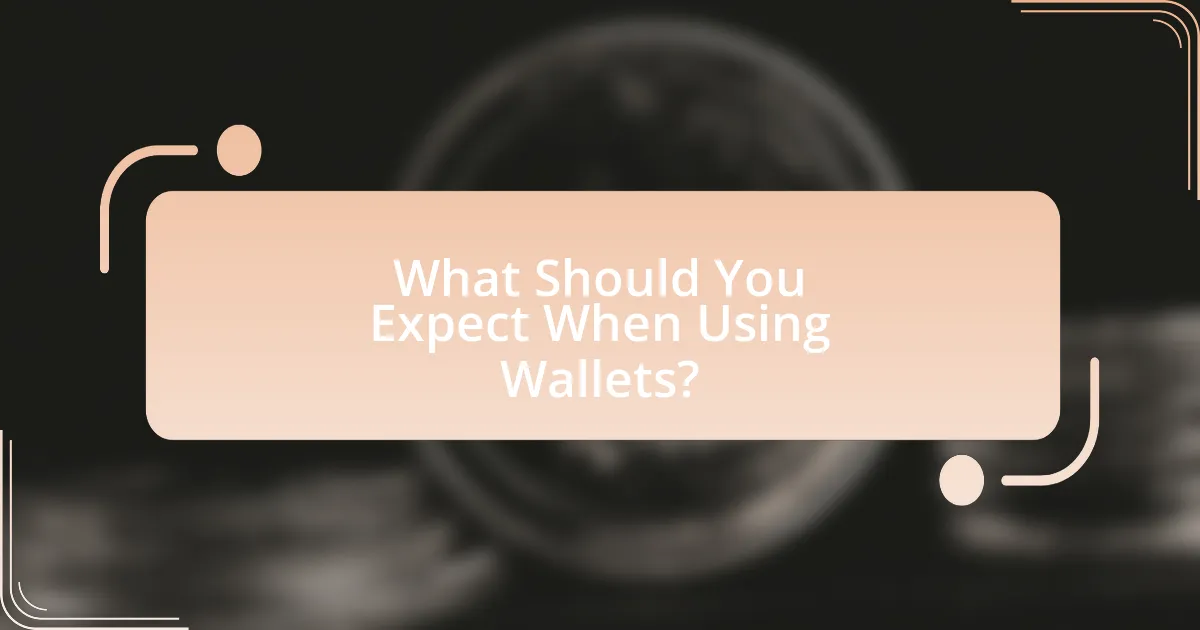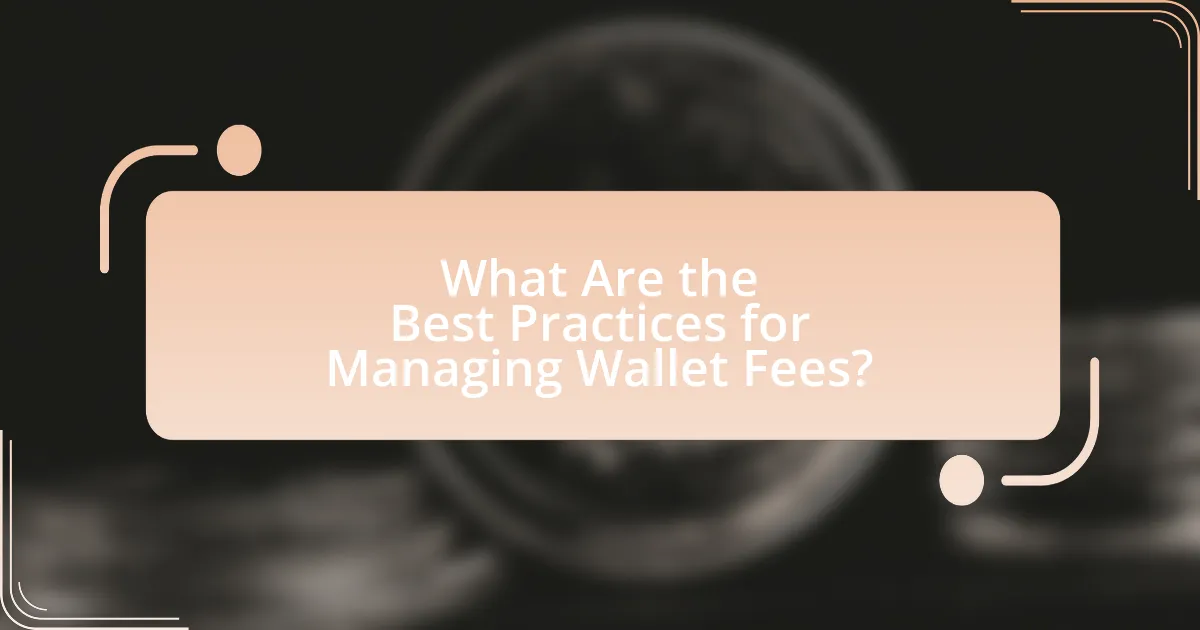Wallet fees are charges incurred when using digital wallets for cryptocurrency transactions, significantly influencing transaction costs and user behavior. This article provides a comprehensive overview of wallet fees, including how they are calculated, the factors that influence them, and the different types of fees users may encounter, such as transaction, withdrawal, and maintenance fees. It also compares fee structures across various wallet types, highlighting the differences between custodial and non-custodial wallets. Additionally, the article offers strategies for minimizing wallet fees and emphasizes the importance of understanding fee structures to enhance the overall wallet experience.

What are Wallet Fees and Why Do They Matter?
Wallet fees are charges associated with the use of digital wallets for transactions, including sending, receiving, or storing cryptocurrencies. These fees matter because they can significantly impact the overall cost of transactions, affecting users’ financial decisions and the efficiency of blockchain networks. For instance, high wallet fees can deter users from making small transactions, while low fees can encourage more frequent use, thereby influencing market dynamics and liquidity.
How are Wallet Fees Calculated?
Wallet fees are calculated based on several factors, including transaction size, network congestion, and the specific wallet provider’s fee structure. For instance, many wallets charge a fee that is a percentage of the transaction amount or a fixed fee per transaction, which can vary depending on the cryptocurrency being used. Additionally, during periods of high network activity, fees may increase to prioritize transactions, as miners or validators require higher compensation for processing. This fee structure is often outlined in the wallet’s terms of service, providing transparency on how fees are determined.
What factors influence the calculation of Wallet Fees?
Wallet fees are influenced by several key factors, including transaction size, network congestion, and the type of cryptocurrency being used. Transaction size directly affects fees because larger transactions require more data to be processed on the blockchain, leading to higher costs. Network congestion plays a significant role as well; during periods of high demand, fees increase due to competition among users to have their transactions prioritized. Additionally, different cryptocurrencies have varying fee structures; for example, Bitcoin typically has higher fees compared to Ethereum due to its block size limitations and transaction processing times. These factors collectively determine the overall wallet fees incurred during transactions.
How do different wallet types affect fee structures?
Different wallet types significantly influence fee structures due to their varying functionalities and underlying technologies. For instance, hardware wallets typically incur higher upfront costs but lower transaction fees, as they prioritize security and offline storage, reducing exposure to network congestion. In contrast, software wallets, especially mobile and web-based options, often have lower initial costs but may charge higher transaction fees during peak network times due to their reliance on third-party services for processing transactions. Additionally, custodial wallets, which manage users’ private keys, may impose ongoing fees for their services, while non-custodial wallets allow users to retain control over their keys, potentially resulting in lower fees. This variability in fee structures is evidenced by the fact that users of hardware wallets can save on transaction fees over time compared to those using custodial wallets, which may charge a percentage of each transaction.
What Types of Wallet Fees Can You Encounter?
You can encounter several types of wallet fees, including transaction fees, withdrawal fees, deposit fees, and maintenance fees. Transaction fees are charged for processing transfers and can vary based on the network congestion and the wallet provider. Withdrawal fees apply when you transfer funds from your wallet to another account or exchange, often reflecting the costs incurred by the provider. Deposit fees may be charged when adding funds to your wallet, particularly with certain payment methods. Maintenance fees are periodic charges for keeping the wallet active, which some providers impose regardless of transaction activity. These fees can significantly impact the overall cost of using a wallet, making it essential to review the fee structure before selecting a wallet service.
What are transaction fees and how do they work?
Transaction fees are charges incurred when processing a transaction, typically in financial systems or blockchain networks. These fees compensate miners or validators for confirming and recording transactions on the network. In blockchain technology, for example, transaction fees vary based on network congestion and the size of the transaction data; higher fees often lead to faster processing times. According to a study by the Cambridge Centre for Alternative Finance, transaction fees can significantly impact the overall cost of using cryptocurrency wallets, influencing user decisions on which wallet to choose.
What are maintenance fees and when are they charged?
Maintenance fees are recurring charges imposed by financial institutions or service providers to cover the costs of managing and maintaining accounts or services. These fees are typically charged monthly or annually and can apply to various accounts, including bank accounts, investment accounts, and digital wallets. For example, a bank may charge a maintenance fee if an account balance falls below a specified minimum threshold or if the account is inactive for a certain period.
What are withdrawal fees and how do they vary?
Withdrawal fees are charges imposed by financial institutions or cryptocurrency exchanges when users withdraw funds from their accounts. These fees can vary significantly based on several factors, including the type of asset being withdrawn, the method of withdrawal (such as bank transfer or cryptocurrency network), and the specific policies of the institution. For example, cryptocurrency exchanges may charge a flat fee or a percentage of the withdrawal amount, while traditional banks might have different fee structures based on account types or withdrawal limits. Additionally, market conditions and network congestion can also influence the fees associated with cryptocurrency withdrawals, leading to fluctuations in costs.
How Do Wallet Fees Compare Across Different Wallets?
Wallet fees vary significantly across different wallets, with some charging transaction fees, while others may have monthly or annual fees. For example, cryptocurrency wallets like Coinbase charge a fee of approximately 1.49% for transactions, while hardware wallets like Ledger typically have no transaction fees but may charge for the initial purchase. Additionally, some wallets, such as Exodus, do not charge fees for sending or receiving cryptocurrencies but may include a spread in the exchange rate. This variability in fees is influenced by factors such as the wallet’s features, security measures, and the types of transactions being conducted.
What are the fee structures of popular wallets?
Popular wallets typically have varying fee structures based on transaction types, currency, and services offered. For instance, Coinbase charges a spread of about 0.5% on cryptocurrency purchases and sales, along with a flat fee that varies by transaction amount. Binance, on the other hand, has a trading fee of 0.1% for spot trading, which can be reduced further by using BNB tokens. PayPal charges a fee of 2.9% plus a fixed fee based on the currency for transactions. These fee structures are designed to cover operational costs and provide revenue for the platforms while offering different services to users.
How do fees differ between custodial and non-custodial wallets?
Custodial wallets typically charge higher fees compared to non-custodial wallets due to the services they provide, such as account management and security. For instance, custodial wallets may impose transaction fees, withdrawal fees, and monthly maintenance fees, which can vary significantly based on the provider. In contrast, non-custodial wallets generally have lower fees since users maintain control over their private keys and transactions, often only incurring network fees associated with blockchain transactions. This difference is evident in platforms like Coinbase (a custodial wallet) versus Exodus (a non-custodial wallet), where Coinbase charges fees for transactions and withdrawals, while Exodus primarily charges only the network fee.

What Should You Expect When Using Wallets?
When using wallets, you should expect varying fees associated with transactions, maintenance, and currency conversions. Wallets can charge transaction fees that typically range from 0.5% to 3% depending on the type of transaction and the wallet provider. Additionally, some wallets may impose monthly or annual maintenance fees, which can average around $1 to $5. Currency conversion fees may also apply when exchanging between different cryptocurrencies or fiat currencies, often around 1% to 2%. Understanding these potential costs is crucial for effective financial planning and maximizing the value of your transactions.
How Can You Minimize Wallet Fees?
To minimize wallet fees, users should choose wallets with low or no transaction fees and utilize features like batch transactions. Selecting wallets that offer fee customization allows users to set their own fees based on urgency, potentially reducing costs. Additionally, using wallets that support off-peak transactions can lead to lower fees, as network congestion often drives costs up. Research indicates that transaction fees can vary significantly based on network conditions; for example, during high traffic, fees can increase by over 200%. Therefore, strategic timing and wallet selection are crucial for minimizing expenses.
What strategies can help reduce transaction fees?
To reduce transaction fees, users can adopt strategies such as choosing wallets with lower fees, utilizing batch transactions, and selecting optimal times for transactions. Wallets like Coinbase and Binance often have fee structures that vary based on transaction volume, so selecting a wallet that aligns with user activity can minimize costs. Additionally, batching multiple transactions into one can significantly decrease fees, as many networks charge per transaction rather than per amount transferred. Timing transactions during off-peak hours can also lead to lower fees, as network congestion typically drives costs up. For instance, Bitcoin transaction fees can fluctuate based on network demand, with average fees dropping significantly during periods of low activity.
How can you choose a wallet with lower fees?
To choose a wallet with lower fees, compare the fee structures of different wallets, focusing on transaction fees, withdrawal fees, and any monthly maintenance fees. Many wallets offer transparent fee schedules, allowing users to evaluate costs effectively. For instance, some wallets charge a flat fee per transaction, while others may have variable fees based on network congestion. Researching user reviews and expert comparisons can also provide insights into which wallets consistently offer lower fees. Additionally, consider wallets that provide fee discounts for higher transaction volumes or loyalty programs, as these can further reduce overall costs.
What Are Common Misconceptions About Wallet Fees?
Common misconceptions about wallet fees include the belief that all wallets charge high fees, that fees are always hidden, and that fees are the same across all platforms. In reality, many wallets offer low or no fees, especially for basic transactions. Additionally, while some wallets may have hidden fees, many provide transparent fee structures that are clearly outlined. Furthermore, fees can vary significantly depending on the type of transaction, the currency used, and the specific wallet provider, making it essential for users to compare options before making a decision.
Why do some users underestimate wallet fees?
Some users underestimate wallet fees due to a lack of awareness about the various costs associated with transactions. Many individuals focus primarily on the nominal value of the cryptocurrency being transferred, neglecting to consider the additional fees that can arise from network congestion, transaction size, and the specific wallet service used. For instance, during periods of high demand, fees can spike significantly, sometimes exceeding the value of the transaction itself. This phenomenon is often exacerbated by the assumption that all wallets operate under similar fee structures, which is not the case; different wallets may have varying fee policies and structures. Consequently, users may not fully grasp the financial implications of their transactions, leading to an underestimation of wallet fees.
How can misinformation about fees lead to poor wallet choices?
Misinformation about fees can lead to poor wallet choices by causing individuals to underestimate or overlook the actual costs associated with using a particular wallet. When users are misled about fees, such as transaction fees or maintenance costs, they may select wallets that appear more favorable but ultimately incur higher expenses over time. For instance, a study by the Consumer Financial Protection Bureau found that consumers often fail to account for hidden fees, leading to financial losses. This lack of accurate information can result in users choosing wallets that do not align with their financial needs, ultimately impacting their overall financial health.

What Are the Best Practices for Managing Wallet Fees?
To effectively manage wallet fees, users should regularly compare fees across different wallets, utilize wallets with transparent fee structures, and optimize transaction timing based on network congestion. Regularly comparing fees helps users identify the most cost-effective options, as fees can vary significantly between wallets. Choosing wallets that clearly outline their fee structures allows users to understand potential costs upfront, reducing unexpected charges. Additionally, optimizing transaction timing by monitoring network congestion can lead to lower fees, as fees often increase during peak times. For instance, Bitcoin transaction fees can fluctuate based on network demand, with average fees reaching as high as $60 during peak periods, according to data from BitInfoCharts.
How Can You Stay Informed About Wallet Fees?
To stay informed about wallet fees, regularly check the official websites or platforms of the wallets you use, as they often provide updated information on fees. Many wallets also have community forums or social media channels where they announce changes in fee structures. Additionally, utilizing comparison websites that aggregate wallet fees can offer insights into current rates across different wallets. According to a study by the Blockchain Research Institute, 70% of users rely on official sources for accurate fee information, highlighting the importance of direct communication from wallet providers.
What resources are available for tracking wallet fees?
Resources available for tracking wallet fees include blockchain explorers, fee estimation tools, and cryptocurrency wallet applications. Blockchain explorers like Blockchair and Etherscan provide real-time data on transaction fees for various cryptocurrencies, allowing users to see current network fees. Fee estimation tools, such as Bitcoinfees.earn.com, offer insights into optimal transaction fees based on network congestion. Additionally, many cryptocurrency wallet applications, including Exodus and Trust Wallet, display estimated fees during the transaction process, helping users make informed decisions. These resources collectively enable users to effectively monitor and manage wallet fees.
How often should you review your wallet’s fee structure?
You should review your wallet’s fee structure at least quarterly. Regular reviews help you stay informed about any changes in fees that could affect your overall costs. According to a study by the Financial Consumer Agency of Canada, consumers who regularly assess their financial products can save an average of 10% on fees annually. This practice ensures that you are utilizing the most cost-effective options available and can help you make informed decisions about your wallet usage.
What Tips Can Help You Navigate Wallet Fees Effectively?
To navigate wallet fees effectively, users should compare fees across different wallets, as fees can vary significantly. Research indicates that transaction fees can range from 0% to over 5% depending on the wallet provider and the type of transaction. Additionally, users should consider the fee structure, such as whether fees are fixed or percentage-based, and choose wallets that offer transparent fee disclosures. Utilizing wallets that allow users to adjust transaction speeds can also help minimize costs, as slower transactions often incur lower fees.
How can understanding fee structures enhance your wallet experience?
Understanding fee structures enhances your wallet experience by allowing users to make informed decisions about their transactions and overall wallet usage. When users comprehend the various fees associated with their wallets, such as transaction fees, withdrawal fees, and maintenance fees, they can better manage their finances and avoid unexpected costs. For instance, a study by the Consumer Financial Protection Bureau found that consumers who understand fee structures are less likely to incur overdraft fees, which can average around $30 per transaction. This knowledge empowers users to select wallets that align with their financial habits, ultimately leading to cost savings and a more efficient wallet experience.
What should you consider before selecting a wallet based on fees?
Before selecting a wallet based on fees, you should consider the types of fees associated with the wallet, such as transaction fees, withdrawal fees, and maintenance fees. Different wallets have varying fee structures; for instance, some may charge a flat fee per transaction while others may take a percentage of the transaction amount. Understanding these fee types helps in evaluating the overall cost of using the wallet. Additionally, consider the frequency of your transactions, as high fees can accumulate quickly with frequent use. Research indicates that wallets with lower fees can save users significant amounts over time, particularly for high-volume traders.